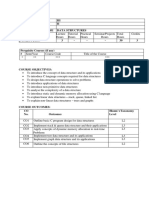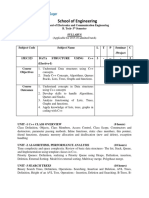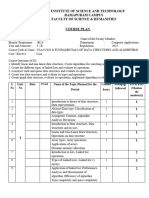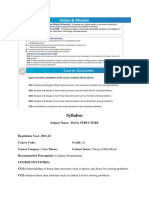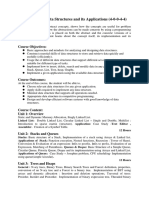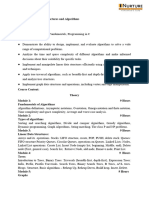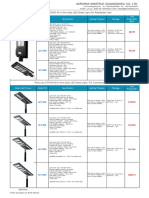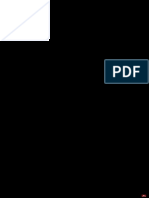Computer Applications 2022
C AND DATA STRUCTURES
Course Code: 22CA3101 LTPC
3 1 0 4
COURSE OUTCOMES:
At the end of the course, student will be able to
CO1: Apply the concept of arrays for storing, sorting and searching data(L3)
CO2: Apply the concept of pointers for dynamic memory management and string handling(L3)
CO3: Develop programs using Stacks and Queues. (L3)
CO4: Develop programs using concepts of trees. (L3)
CO5: Apply concepts of graphs(L3)
UNIT-I (10 Lectures)
An Overview of C, Basic Data types, modifying the basic data types, identifier names, Variables,
type Qualifiers, Constants, Operators, Expressions. Selection, Iteration and Jump Statements
Functions: Designing Structured Programs, Functions Basics, Standard Library Functions, User
Defined Functions, Categories of functions, Parameter passing techniques, Scope, Scope Rules,
Storage Classes and Type Qualifiers. Recursion: Recursive Functions, Preprocessor directives.
Arrays: Concepts, Using Arrays in C, Inter-Function Communication using arrays, Array
Applications, Two Dimensional Arrays, Introduction to Multidimensional Arrays, Strings –
Concepts, C Strings, String Input/output Functions, Arrays of Strings, String Manipulation functions.
Learning Outcomes:
At the end of the module, the student will be able to
Apply the concepts of arrays in solving problems (L3)
Develop programs that mimics string functions in solving problems (L3)
UNIT-II (10 Lectures)
Pointers: Introduction, Pointer Arithmetic, Pointers for Inter-Function Communication, Pointers to
Pointers, Arrays and Pointers- Array of Pointers, Pointer to Array, Pointers to void, Pointers to
Functions, Command Line Arguments.
Dynamic Memory Allocation Functions, Programming Applications.
Learning Outcomes:
At the end of the module, the student will be able to
Apply the concepts of pointers with respect to arrays, structures and functions (L3)
Demonstrate the usage of dynamic memory allocation functions to solve problems (L2)
UNIT-III (10 Lectures)
Stacks: Introduction, stack operations, applications.
Queues: Introduction, Operations on queues, circular queues, Priority queues, applications.
Introduction, Singly linked lists, circular linked lists, doubly linked lists, multiple linked lists,
applications. Linked stacks and linked queues: Introduction, operations on linked stacks and linked
queues, dynamic memory management, implementation of linked representations, applications.
Learning Outcomes:
At the end of the module, students will be able to
�Computer Applications 2022
Identify the advantages of linked implementation over array implementation of various data
structures.(L3)
Demonstrate how to declare structures to be used in simple linked lists, double linked lists, and
circular linked lists. (L2)
Build the algorithms for inserting, deleting, and searching in a simple linked list. (L3)
UNIT-IV (10 Lectures)
Searching: Introduction, linear search, binary search, Fibonacci search. Internal sorting: Introduction,
bubble sort, insertion sort, Quick sort Trees and binary trees: Introduction, Trees: definition and basic
terminologies, representation of trees. Binary trees: basic terminologies and types, representation
of binary trees, binary tree traversals, applications.
Learning Outcomes:
At the end of the module, students will be able to
Explain what is meant by a binary tree and binary search tree and why it is important. (L2)
Demonstrate how to declare structures to be used in binary trees. (L2)
Develop the algorithms for inserting, deleting, and searching for nodes in a binary tree. (L3)
Demonstrate Searching and sorting techniques. (L2)
UNIT-V (10 Lectures)
GRAPHS:
Introduction, definitions and basic terminologies, representations of graphs, Minimal Spanning Trees
graph traversals (BFS, DFS) and applications.
Learning Outcomes:
At the end of the module, students will be able to
Demonstrate the searching algorithm in graphs. (L2)
Explain the minimal spanning tree with diagrams and Prim's algorithm for finding the
minimal spanning tree of a graph. (L3)
Explain shortest path with diagrams and Dijkstra's algorithm for finding the shortest path
from node x to node y of a graph. (L3)
TEXT BOOKS:
1. G.A.V PAI, Data Structures and Algorithms, Concepts, Techniques and Applications,Volume 1,1 st
Edition,Tata McGraw-Hill, 2008. Master of Computer Applications (Two Year Programme) R-2020
Regulations 14
2. Richard F. Gilberg&Behrouz A. Forouzan, Data Structures, Pseudo code Approach with C, 2 nd Edition,
Cengage Learning India Edition, 2007.
REFERENCE TEXT BOOKS:
1. Langsam, M. J. Augenstein, A. M. Tanenbaum, Data structures using C and C++, 2 nd Edition,
PHIEducation, 2008.
2. SartajSahni, Ellis Horowitz, Fundamentals of data Structures in C, 2nd Edition, Orient Blackswan, 2010.
WEB REFERENCES:
http://nptel.iitm.ac.in/video.php?subjectId=106105085.
https://www.cs.usfca.edu/~galles/visualization/Algorithms.html.
